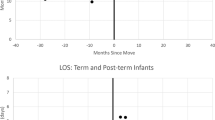Abstract
BACKGROUND: Acquired infection is one of the most prevalent sources of concern in neonatal intensive care units (NICUs). Center-to-center variation has been noted by both the National Nosocomial Infection Surveillance System and the Vermont Oxford Network suggesting that site of care influences outcomes including acquired infection.
OBJECTIVE: To reduce the acquired infection rate by isolating and then implementing meaningful process differences between high and low infection rate centers.
DESIGN/METHOD: A multistaged observation and intervention study. The primary outcome measure was defined as a positive blood culture, collected more than 3 days after birth. Hospital patient days along with infection episodes were collected for all NICU admissions in the network during the baseline and postimplementation periods. A detailed observation guide was used during site visits to high and low infection rate centers. The observations recorded in the guide allowed the team to isolate meaningful differences, which were shared with the network. Individual NICUs decided which of the meaningful differences, if any, to implement. To estimate the impact on costs, additional data were gathered in a case-matched series of infants in one demonstration site.
RESULTS: In all, 15 meaningful differences were isolated and shared with the network. The network rate for acquired infection dropped from 3.8 to 2.9 episodes per 1000 patient days. In the demonstration site, the infection rate dropped from 7.4 to 4.0 per 1000 patient days.
CONCLUSION: Isolation of process level differences between high and low performing centers followed by implementation of these meaningful differences may reduce acquired infections. Other targeted areas of care may benefit from this quality improvement methodology.
This is a preview of subscription content, access via your institution
Access options
Subscribe to this journal
Receive 12 print issues and online access
$259.00 per year
only $21.58 per issue
Buy this article
- Purchase on Springer Link
- Instant access to full article PDF
Prices may be subject to local taxes which are calculated during checkout
Similar content being viewed by others
References
Horbar JD, Gould JB . Evidence–based quality improvement in neonatal and perinatal medicine. Pediatrics 1999(Suppl);103(1):203–393.
Copyright held by and licensed to HCA by the Lombardy Group, LLC.
Stoll BJ, Gordon T, Korones S, et al. Late onset sepsis in very low birth weight neonates: A report from the National Institutes of Child Health and Human Development Neonatal Research Network. J Pediatr 1996;129:63–71.
Stoll BJ, Hansen N, Fanaroff AA, et al. Late-onset sepsis in very low birth weight neonates: the experience of the NICHD Neonatal Research Network. Pediatrics 2002;110(2 Part 1):285–291.
Horbar JD, Badger GJ, Lewit EM, et al. Hospital and patient characteristics associated with variation in 28-day mortality rates for very low birth weight infants. Pediatrics 1997;99:149–156.
Gaynes RP, Edwards JR, Jarvis WR, et al. Nosocomial infections among neonates in high-risk nurseries in the United States. Pediatrics 1996;98:357–361.
Rogowski J . Measuring the cost of neonatal and perinatal care. Pediatrics 1999;103:e329.
Bloom BT, Clark RH, Mulligan J, et al. Improving weight gain in VLBW infants during the first 28 days. Abstract; Presented at the AAP Meeting, San Francisco, October 2001.
Author information
Authors and Affiliations
Additional information
A subset of this experience was presented at the Pediatric Academic Society Meeting, Baltimore, MD, USA, May 2001.Funding provided by Columbia/HCA, Now HCA Healthcare Corporation.
Rights and permissions
About this article
Cite this article
Bloom, B., Craddock, A., Delmore, P. et al. Reducing Acquired Infections in the NICU: Observing and Implementing Meaningful Differences in Process Between High and Low Acquired Infection Rate Centers. J Perinatol 23, 489–492 (2003). https://doi.org/10.1038/sj.jp.7210981
Published:
Issue Date:
DOI: https://doi.org/10.1038/sj.jp.7210981
This article is cited by
-
The complete blood cell count in a refined cohort of preterm NEC: the importance of gestational age and day of diagnosis when using the CBC to estimate mortality
Journal of Perinatology (2016)
-
Effect of prophylactic CPAP in very low birth weight infants in South America
Journal of Perinatology (2016)
-
Efficacy of interventions to improve hand hygiene compliance in neonatal units: a systematic review and meta-analysis
European Journal of Clinical Microbiology & Infectious Diseases (2015)
-
Variations in rates of nosocomial infection among Canadian neonatal intensive care units may be practice-related
BMC Pediatrics (2005)
-
Prevention and Treatment of Nosocomial Sepsis in the NICU
Journal of Perinatology (2004)



